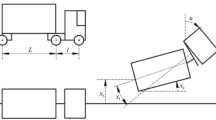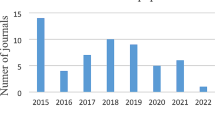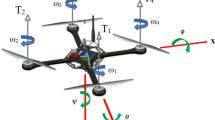Abstract
In this paper, a new systematic approach is presented to further decrease the conservativeness in stability analysis condition and controller design. Non-quadratic Lyapunov function is utilized to derive stability conditions in terms of linear matrix inequalities. Also, the control problem is formulated in a generalized eigenvalue problem. Considering the concept of decay rate and control input constraint, a new systematic procedure is proposed to calculate a maximum bound for the upper bounds of the time derivatives of the membership functions. Moreover, some slack matrices are introduced that help to reduce conservativeness. The number of inequalities is few compared to the existing results in literature, which helps the feasibility in the case of large number of fuzzy rules. Simulation examples and comparison results demonstrate the merits of this method.
Similar content being viewed by others

References
K. Tanaka, Fuzzy Control Systems Design and Analysis: A Linear Matrix Inequality Approach, Wiley, New York, 2001.
S.-P. He, “Fault estimation for T-S fuzzy Markovian jumping systems based on the adaptive observer,” Int. J. Control Autom. Syst., vol. 12, no. 5, pp. 977–985, October 2014.
E. T. Jeung and K. R. Lee, “Static output feedback control for continuous-time T-S fuzzy systems: an LMI approach,” Int. J. Control Autom. Syst., vol. 12, no. 3, pp. 703–708, June 2014.
S. Idrissi, E. H. Tissir, I. Boumhidi, and N. Chaibi, “New delay dependent robust stability criteria for T-S fuzzy systems with constant delay,” Int. J. Control Autom. Syst., vol. 11, no. 5, pp. 885–892, October 2013.
H. Wang and G.-H. Yang, “Robust H ∞ filter design for affine fuzzy systems,” Int. J. Control Autom. Syst., vol. 11, no. 2, pp. 410–415, April 2013.
M. Chadli, H. R. Karimi, and P. Shi, “On stability and stabilization of singular uncertain Takagi–Sugeno fuzzy systems,” J. Frankl. Inst., vol. 351, no. 3, pp. 1453–1463, March 2014.
G. Feng, C.-L. Chen, D. Sun, and Y. Zhu, “H_inf controller synthesis of fuzzy dynamic systems based on piecewise Lyapunov functions and bilinear matrix inequalities,” IEEE Trans. Fuzzy Syst., vol. 13, no. 1, pp. 94–103, February 2005.
K. Tanaka, T. Hori, and H. O. Wang, “A multiple Lyapunov function approach to stabilization of fuzzy control systems,” IEEE Trans. Fuzzy Syst., vol. 11, no. 4, pp. 582–589, 2003.
I. Abdelmalek, N. Goléa, and M. Hadjili, “A new fuzzy Lyapunov approach to non-quadratic stabilization of Takagi–Sugeno fuzzy models,” Int. J. Appl. Math. Comput. Sci., vol. 17, no. 1, pp. 39–51, January 2007.
L. A. Mozelli, R. M. Palhares, and G. S. C. Avellar, “A systematic approach to improve multiple Lyapunov function stability and stabilization conditions for fuzzy systems,” Inf. Sci., vol. 179, no. 8, pp. 1149–1162, March 2009.
D. Saifia, M. Chadli, H. R. Karimi, and S. Labiod, “Fuzzy control for electric power steering system with assist motor current input constraints,” J. Frankl. Inst., vol. 352, no. 2, pp. 562–576, February 2015.
T. M. Guerra, M. Bernal, K. Guelton, and S. Labiod, “Non-quadratic local stabilization for continuous-time Takagi–Sugeno models,” Fuzzy Sets Syst., vol. 201, no. 16, pp. 40–54, August 2012.
M. Sha Sadeghi and N. Vafamand, “More relaxed stability conditions for fuzzy TS control systems by optimal determination of membership function information,” J. Control Eng. Appl. Inform., vol. 16, no. 2, pp. 67–77, 2014.
M. Sha Sadeghi,_N. Vafamand, and M. S. Babaei, “Non-quadratic exponential stabilisation of nonlinear hyperbolic partial differential equation systems,” IET Sci. Meas. Technol., vol. 8, no. 6, pp. 537–545, November 2014.
W.-J. Chang, C.-H. Chang, and C.-C. Ku, “Fuzzy controller design for Takagi–Sugeno fuzzy models with multiplicative noises via relaxed non-quadratic stability analysis,” Proc. Inst. Mech. Eng. Part J. Syst. Control Eng., vol. 224, no. 8, pp. 918–931, December 2010.
W.-J. Chang, C.-C. Ku, and C.-H. Chang, “PDC and non-PDC fuzzy control with relaxed stability conditions for continuous-time multiplicative noised fuzzy systems,” J. Frankl. Inst., vol. 349, no. 8, pp. 2664–2686, October 2012.
D. H. Lee, Y. H. Joo, and M. H. Tak, “Local stability analysis of continuous-time Takagi–Sugeno fuzzy systems: a fuzzy Lyapunov function approach,” Inf. Sci., vol. 257, no. 1, pp. 163–175, February 2014.
B.-J. Rhee and S. Won, “A new fuzzy Lyapunov function approach for a Takagi–Sugeno fuzzy control system design,” Fuzzy Sets Syst., vol. 157, no. 9, pp. 1211–1228, May 2006.
C. Scherer and S. Weiland, “Linear Matrix Inequalities In Control,” Dutch Institute for Systems and Control, Delft, The Netherlands, 2000.
M. Namazov, B. Tekgun, and I. E. Celikkale, “Design of stable Takagi–Sugeno fuzzy control system via LMIs with constraint on the input/output and initial state independence,” Proc. of the 2nd Int. Symposium on Computing in Science and Engineering, pp. 950–956, 2011.
W.-J. Chang, G. J. Chen, and Y. L. Yeh, “Fuzzy control of dynamic positioning systems for ships,” J. Mar. Sci. Technol. Mar. Sci. Technol., vol. 10, no. 1, pp. 47–53, 2002.
Author information
Authors and Affiliations
Corresponding author
Additional information
Recommended by Associate Editor Myung Geun Chun under the direction of Editor-in-Chief Young Hoon Joo.
Navid Vafamand received his B.S. and M.S. degrees from the Electrical Engineering Department, Shiraz University of Technology, Shiraz, Iran, in 2012 and 2014, respectively. His research interests include fuzzy model based control, LMI and adaptive control.
Mokhtar Sha Sadeghi received his B.S. degree in Electronics Engineering from Shiraz University, Shiraz in 1996, and his M.Sc. and Ph.D. degrees from Tarbiat Modares University, in 2001 and 2007, respectively, all in Iran. His research interests include robust control, adaptive control, fuzzy control, time delay systems, optimization, LMI, and neural networks.
Rights and permissions
About this article
Cite this article
Vafamand, N., Sha Sadeghi, M. More relaxed non-quadratic stabilization conditions for TS fuzzy control systems using LMI and GEVP. Int. J. Control Autom. Syst. 13, 995–1002 (2015). https://doi.org/10.1007/s12555-013-0497-7
Received:
Revised:
Accepted:
Published:
Issue Date:
DOI: https://doi.org/10.1007/s12555-013-0497-7



